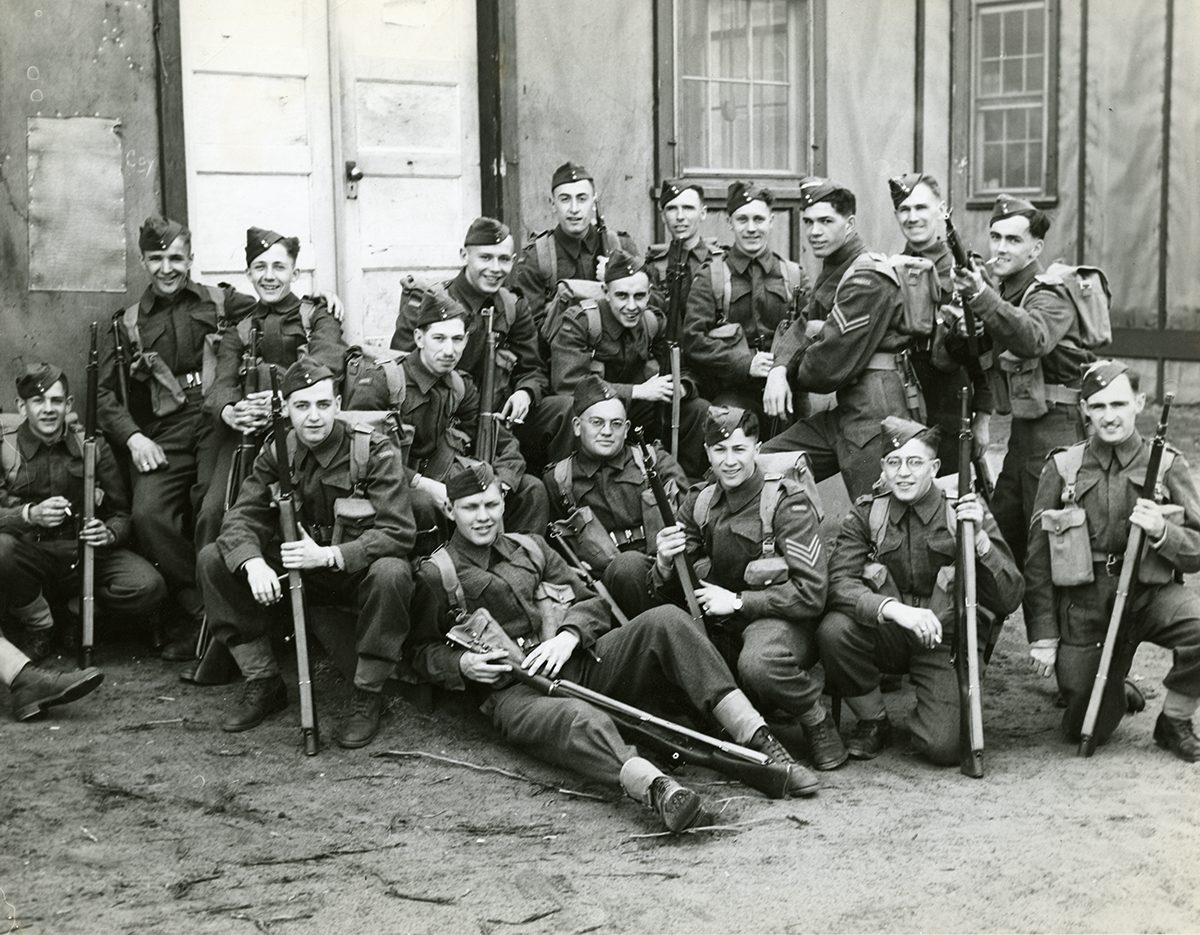
U of M Canadian Officers Training Corp (COTC) members at training camp in 1945 // Photo courtesy of UM Digital Collections
The war effort
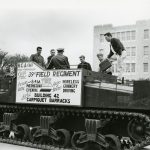
Tank on U of M Campus // Photo courtesy of UM Digital Collections
During the First and Second World Wars, the University of Manitoba served as a training ground for troops and watched some of its best and brightest go off and fight for their country.
In 1914-15, University Council established a Committee on Military Instruction and authorized the teaching of military science and tactics. A university corps was organized and during the term, men drilled, and sixty-four of them took extra classes to qualify as officers. In 1916, an Overseas Correspondence Club was established to write letters to University of Manitoba students serving in England and France during World War I in order to keep them in touch with activities at the University during their absence.
By the time the First World War ended on November 11, 1918, a total of 1160 students and 14 faculty and staff from the University had enlisted. 123 were killed or died during the war and 142 received military honours.
With the outbreak of the Second World War in 1939, University facilities were pressed into service for the Canadian Armed Forces. The Dominion of Canada, by January 1, 1941, leased the Residence (then called the Manitoba Union) for the Commonwealth Air Training Plan. The government constructed a heavy wire fence across the campus, separating the Residence and most of the buildings to the south from the rest of the university. During the Commonwealth Air Training Plan, 3,000 soldiers were housed in the Residence at one time, spending $25,000 on structural changes and paying $17,000 to the U of M as a recompense for the loss.
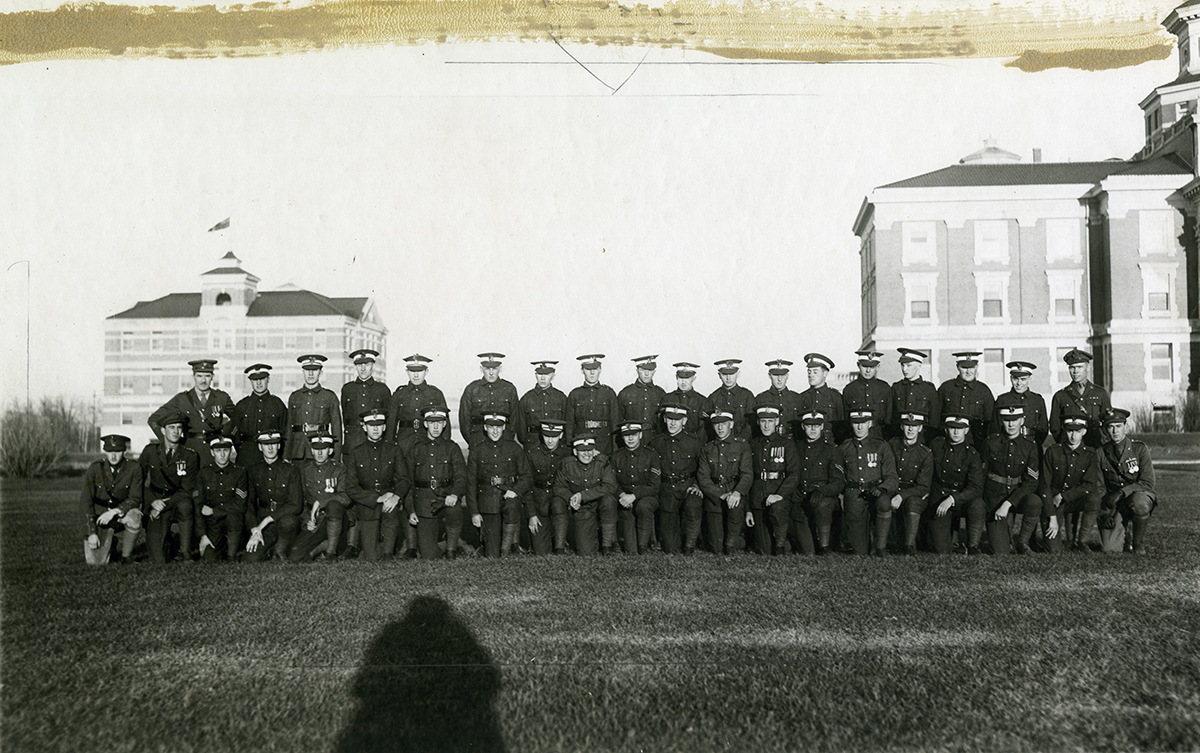
U of M Canadian Officer Training Corps members lined up in front of the Home Economics and Agriculture buildings at the U of M // Photo courtesy of UM Digital Collections
The War had a dramatic effect on the University, not only in its enrolment, but also in the physical presence of soldiers as the Army took over the Fort Garry residence. All fit, 18-year-old male students were required to take six hours a week in military training. Students over the age of 21 received two weeks of practical military training in a camp. And by 1941, 90 per cent of women students had enrolled in a variety of courses to aid in the war. Auto mechanics proved to be a favourite course among women, and for the first time, women wore slacks in residence and the library.
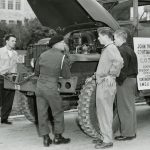
U of M Canadian Officer Training Corp members and a jeep on campus // Photo courtesy of UM Digital Collections
The Residence was occupied in early 1941 for a navigation school, and by 1942 the army had constructed a number of temporary buildings (called “huts”) on the south side of the campus. The University also (with federal assistance) built a hut (designated “J”) in order to provide a cafeteria for students while the Residence was out of bounds. Situated where the Mauro Residence sits now, Hut J was later to become the first building for the Faculty of Education.
Indoor facilities had to be provided for army training purposes during the severe Manitoba winters. An old roller skating rink that was on the corner of Osborne Street at Jubilee in old River Park was physically moved to the campus. It was rebuilt to become the Drill Hall before it was finally converted in 1952 to the Bison Gardens Skating Rink. Parallel to and north of the Drill Hall, the army also constructed an indoor rifle range, which was used for recreational shooting until well into the 1970s.
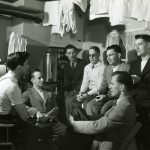
Group of men in a house in Veterans’ Village // Photo courtesy of UM Digital Collections
During the war period, student activities were very much simplified, with the scarcity of resource and “the discovery that, with Saturdays devoted to hard military work, Friday nights had ceased to be desirable for social life.” It was a time of great seriousness, and this was, perhaps, reflected in the report of the Dean of Women. She said, of the peaceful coexistence of the students and the soldiers:
The spirit between the two bodies is one of mutual respect and good will, but of detachment. Each attends its own work without curiosity about the other and there has been a total lack of “incidents” on both sides.
Following the Second World War, the university played a critical role in helping troops complete their education and re-enter civilian life. Accommodation for the returning veterans was provided for by means of temporary housing clustered around central utility buildings. The temporary buildings were built by the Central Mortgage and Housing Corporation and the Veterans’ Department. Three of the “veterans’ villages” were situated south of the Drill Hall and the fourth one was built on the north part of the campus just west of the President’s House. The veterans’ villages had a short life and were destroyed in the great flood of 1950.
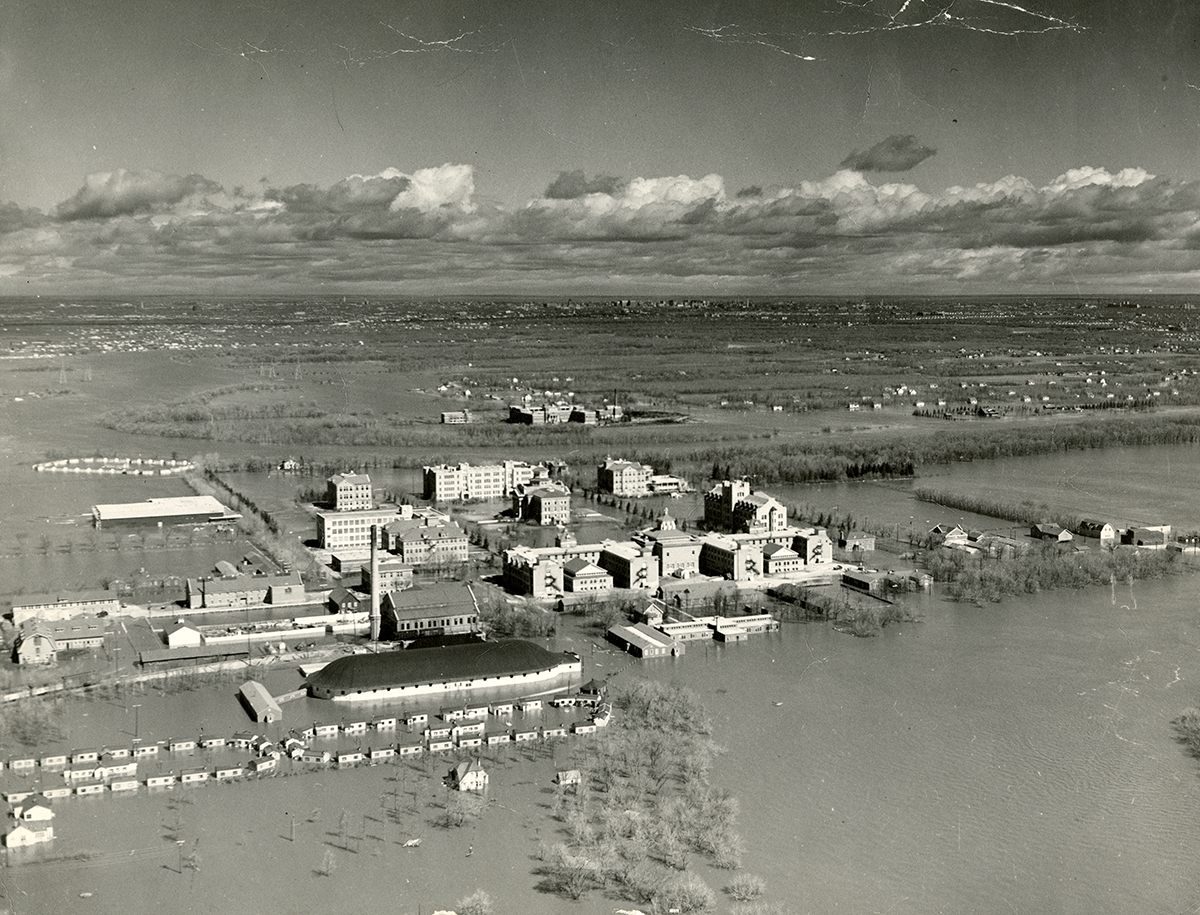
Arial photo of the U of M campus during the flood of 1950. Veterans' Village can bee seen in the bottom right of the photograph. // Photo courtesy of UM Digital Collections
The years 1945-46 in many ways showed signs of a gradual return to a more normal way of life. This was noticeable within the University as well as elsewhere, and one of the indications that things were getting to be more as they should be was the fact that the Residence was no longer a barracks for a military training centre, but was now a “temporary home” for students who came from out of town. East Taché was just called “Women’s Residence” for and West Taché was “Men’s Residence.”
By 1946, Berlin and Tokyo had fallen. V.E. Day and V.J. Day had come and gone and the world was in the process of moving from war to peace. The University campus was humming with the voices of returning servicemen, and rehabilitation and re-establishment were the guiding principles. Peace had returned to Canada, and especially on the University of Manitoba campus.
Members from the U of M community who gave their lives were recognized after the First World War with the planting of the Avenue of Elms stretching from the Administration Building to Pembina Highway along Chancellor Matheson Drive. Staff, students and alumni of the Manitoba Agricultural College planted the trees to honour the students who gave up their lives fighting in the First World War. The names of the fallen soldiers are inscribed in the entrance to the administration building and the man who came up with the idea for the Avenue of the Elms is buried beneath the first elm.
The plaque at the base of the tree reads:
In memoriam
Wilfrid John Rae, B.S.A.,M.S.c
1899-1979
Whose cremated remains are buried under
the elm tree he planted in 1923
opposite the south west corner of the
Administration Building site.
Many of these elms have long ago entered their twilight years so a reforestation plan was developed. In 2014, the university began a long-term plan to plant 100 new elms to keep the Avenue of Elms preserved for future generations.






